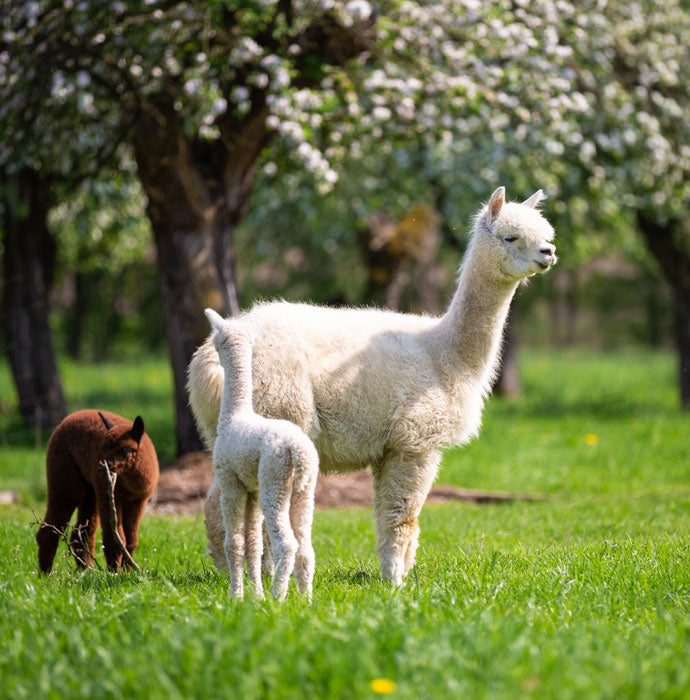
Sunny Hill in a Lovely Valleys
Our alpaca ranch is situated on a sunny hill in the lovely Coldstream valley, near Vernon, in the Okanagan valley. Canadian Okanagan Alpaca Ranch is committed to breed alpacas which produce some of the finest fleece possible today. We exclusively manufacture and sell our fleece products through COKAL Inc. The 15 acre alpaca ranch allows for up to 70 alpacas to graze on green pastures of Orchard grass mixed with lupine, which adds to their nutrition. The grass keeps the fleece of our animals clean and offers them a healthy diet. That is important for the fleece quality. In addition, we feed a specifically developed supplementary nutrition to keep our animals healthy and improve fleece quality. Our alpacas have access to fresh water all the time. It is very important to clean up the pastures frequently to avoid the spread of diseases.
Our alpacas live outside year around. But shelters allow for shadow and protection against rain and snow. A 6-foot high fence protects them from predators. Straying dogs, coyotes, cougars, and bears are their most dangerous enemies living in our area. Even more important in our opinion are guardian dogs to secure the alpacas’ safety. We keep Maremmas on the alpaca ranch. They live together with the flock of alpacas and keep predators away. We developed our own breeding program. All foundation animals, females as well as males, are carefully selected for their fleece quality.

Origin and Spreading of Alpacas
They originated from the Andes mountains in South America, namely Peru, Chile and Bolivia. They were domesticated by the ancient inhabitants of the Altiplano, the Incas, thousands of years back. At the times of the Incas, only royals and clerics were allowed to wear alpaca fleece clothing. It was called the "The Fibre of the Gods" or the "Gold of the Andes". While the hair of sheep is called wool, the hair of alpacas and vicunas is named fleece to highlight the unique quality. When the Spanish conquered Peru they decimated the alpaca herds and alpacas were almost eliminated. In the last century the government of Peru encouraged the native population again to breed Alpacas to boost the economy.
Meanwhile 3.5 million alpacas live in South America. The first alpacas, in considerable numbers, were exported to North America, Australia and New Zealand in the 1980s and 1990s later to Europe.
The number of Alpacas living in North America now reaches 150,000 and exceeds 200,000 in Australia.
Vicunas and Paco-Vicunas
Vicunas, living in the Andes mountains of Peru, are still not domesticated and their export is prohibited. This secures a monopoly to Peru to produce and export vicuna fleece. Vicuna fleece is the most exclusive and expensive exotic fibre of the world. Vicunas produce less fleece compared to alpacas. They are shorn every three or four years in big events called Chaccu.
We would like to mention briefly another breed, the paco-vicunas. They are a mix of vicunas and alpacas exhibiting more of the fineness of vicunas, but they give a little bit more fleece compared to vicunas. In this regard they are nearer to alpacas. Nevertheless, currently it is uneconomic to breed them for their fleece.



